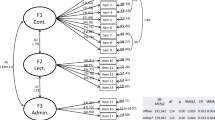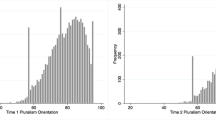Abstract
This article presents the results of evaluating a dataset collected with the Community of inquiry (CoI) survey (Arbaugh, The International Review of Research in Open and Distributed Learning 9:1–21, 2008) using Rasch psychometric techniques to evaluate instrument functioning. Data were collected over a two-year period yielding a sample of 704 survey responses from students who were enrolled in a blended online graduate program. The purpose of this article is to present a Rasch analysis of the CoI survey to provide insight into the functioning of the instrument beyond other statistical analyses of the CoI that have been conducted to date. The results of the analysis provide new insights into the functioning of this measurement instrument and demonstrate the usefulness of Rasch techniques. The rationale for using Rasch techniques as well as the implications of this technique when using the CoI survey when conducting research or evaluations of practices in blended online courses are discussed.

Source: http://www.thecommunityofinquiry.org/coi (licensed under CC BY-SA 4.0)






Similar content being viewed by others
References
Akyol, Z., & Garrison, D. R. (2008). The development of a community of inquiry over time in an online course: Understanding the progression and integration of social, cognitive and teaching presence. Journal of Asynchronous Learning Networks, 12(3–4), 3–22.
Andrich, D. (1978). A rating formulation for ordered response categories. Psychometrika, 43, 561–573.
Arbaugh, J. B. (2008). Does the community of inquiry framework predict outcomes in online MBA courses? The International Review of Research in Open and Distributed Learning, 9(2), 1–21.
Arbaugh, J. B., Bangert, A., & Cleveland-Innes, M. (2010). Subject matter effects and the community of inquiry (CoI) framework: An exploratory study. The Internet and Higher Education, 13(1–2), 37–44.
Arbaugh, J., Cleveland-Innes, M., Diaz, S. R., Garrison, D. R., Ice, P., Richardson, J. C., & Swan, K. P. (2008). Developing a community of inquiry instrument: Testing a measure of the community of inquiry framework using a multi-institutional sample. The Internet and Higher Education, 11(3–4), 133–136.
Bangert, A. (2008). The influence of social presence and teaching presence on the quality of online critical inquiry. Journal of Computing in Higher Education, 20(1), 34–61.
Boone, W., Staver, J., & Yale, M. (2014). Rasch analysis in the human sciences. Dordrect: Springer.
Caskurlu, S. (2018). Confirming the subdimensions of teaching, social, and cognitive presences: A construct validity study. The Internet and Higher Education, 39, 1–12.
Choi, B. (2018). Cross-cultural adaptation and construct validity of the Korean version of a physical activity measure for community-dwelling elderly. The Journal of Physical Therapy Science, 30, 177–180. https://doi.org/10.1589/jpts.30.177.
Cleveland-Innes, M., & Campbell, P. (2012). Emotional presence, learning, and the online learning environment. International Review of Research in Open and Distance Learning, 13(4), 269–292.
Community of Inquiry Survey. (n.d.). Retrieved from https://coi.athabascau.ca/coi-model/coi-survey/
Díaz, S. R., Swan, K., Ice, P., & Kupczynski, L. (2010). Student ratings of the importance of survey items, multiplicative factor analysis, and the validity of the community of inquiry survey. The Internet and Higher Education, 13(1), 22–30.
Fisher, W. (1992). Reliability, separation, strata statistics. Rasch Measurement Transactions, 6(3), 238.
Garrison, D. R. (2009). Communities of inquiry in online learning. Encyclopedia of distance learning (2nd ed., pp. 352–355). IGI Global: Taylor & Francis.
Garrison, D. R. (2016). E-Learning in the 21st century : A community of inquiry framework for research and practice (3rd ed.). Routledge: Taylor & Francis.
Garrison, D. R., & Akyol, Z. (2009). Role of instructional technology in the transformation of higher education. Journal of Computing in Higher Education, 21(1), 19.
Garrison, D. R., Anderson, T., & Archer, W. (2000). Critical inquiry in a text-based environment: Computer conferencing in higher education. The Internet and Higher Education, 2(2), 87–105.
Garrison, D. R., Anderson, T., & Archer, W. (2001). Critical thinking, cognitive presence, and computer conferencing in distance education. The American Journal of Distance Education, 15(1), 7–23.
Garrison, D. R., Anderson, T., & Archer, W. (2010). The first decade of the community of inquiry framework: A retrospective. The Internet and Higher Education, 13(1–2), 5–9.
Graham, C. R. (2009). Blended learning models. Encyclopedia of Information Science and Technology (2nd ed., pp. 375–382). Pennsylvania: IGI Global.
Horzum, M. B., & Uyank, G. K. (2015). An item response theory analysis of the community of inquiry scale. International Review of Research in Open & Distance Learning, 16(2), 206–226.
Kovanović, V., Joksimović, S., Poquet, O., Hennis, T., Čukić, I., de Vries, P., et al. (2018). Exploring communities of inquiry in massive open online courses. Computers and Education, 119, 44–58. https://doi.org/10.1016/j.compedu.2017.11.010.
Linacre, J. M. (2002a). Optimizing rating scale category effectiveness. Journal of Applied Measurement, 3(1), 85–106.
Linacre, J. M. (2002b). What do infit and outfit, mean-square and standardized mean? Rasch Measurement Transactions, 16(2), 878.
Linacre, J. M. (2003). Rasch power analysis: Size vs. significance: Infit and outfit mean-square and standardized chi-square fit statistic. Rasch Measurement Transactions, 16(2), 878.
Linacre, J. M. (2018). Winsteps® Rasch measurement computer program User’s Guide. Beaverton, Oregon: Winsteps.com.
Maddrell, J. A., Morrison, G. R., & Watson, G. S. (2011). Community of inquiry framework and learner achievement. In: annual meeting of the Association of Educational Communications and Technology, Jacksonville, FL.
Malec, J. F., Torsher, L. C., Dunn, W. F., Wiegmann, D. A., Arnold, J. J., Brown, D. A., & Phatak, V. (2007). The mayo high performance teamwork scale: reliability and validity for evaluating key crew resource management skills. Simulation in Healthcare: Journal of the Society for Simulation in Healthcare, 2(1), 4–10.
Martin, F., Wang, C., & Sadaf, A. (2018). Student perception of helpfulness of facilitation strategies that enhance instructor presence, connectedness, engagement and learning in online courses. The Internet and Higher Education, 37, 52–65. https://doi.org/10.1016/j.iheduc.2018.01.003.
Messick, S. (1989). Validity. In R. L. Linn (Ed.), Educational measurement (3rd ed., pp. 13–103). New York: Macmillan.
O’Connor, J. P., Penney, D., Alfrey, L., Phillipson, S., Phillipson, S. N., & Jeanes, R. (2016). The development of the Stereotypical attitudes in HPE scale. Australian Journal of Teacher Education, 41(7), 70–87.
Perera, C. J., Bambang, S., & Na, J. (2018). The psychometric validation of the principal practices questionnaire based on item response theory. International Online Journal of Educational Leadership, 2(1), 21–38.
Rasch, G. (1960). Probabilistic model for some intelligence and achievement tests. Copenhagen: Danish Institute for Educational Research.
Reliability and separation of measures. (n.d.). Retrieved February 5, 2019, from https://www.winsteps.com/winman/reliability.htm
Sener, J. (2015). E-Learning Definitions. Retrieved from https://onlinelearningconsortium.org/updated-e-learning-definitions-2/
Shea, P., & Bidjerano, T. (2009). Cognitive presence and online learner engagement: A cluster analysis of the community of inquiry framework. Journal of Computing in Higher Education, 21(3), 199–217.
Shea, P., & Bidjerano, T. (2010). Learning presence: Towards a theory of self-efficacy, self-regulation, and the development of a communities of inquiry in online and blended learning environments. Computers and Education, 55(4), 1721–1731.
Stenbom, S. (2018). A systematic review of the community of inquiry survey. The Internet and Higher Education, 39, 22–32.
Swan, K. P., Richardson, J. C., Ice, P., Garrison, D. R., Cleveland-Innes, M., & Arbaugh, J. B. (2008). Validating a measurement tool of presence in online communities of inquiry. E-Mentor, 2(24), 1–12.
Wicks, D. A., Craft, B. B., Mason, G. N., Gritter, K., & Bolding, K. (2015). An investigation into the community of inquiry of blended classrooms by a faculty learning community. The Internet and Higher Education, 25, 53–62.
Wright, B. D., & Masters, G. (1982). Rating scale analysis. Chicago, IL: MESA Press.
Wright, B. D., & Stone, M. (1999). Measurement essentials. Wilmington, DE: Wide Range Inc.
Author information
Authors and Affiliations
Corresponding author
Additional information
Publisher's Note
Springer Nature remains neutral with regard to jurisdictional claims in published maps and institutional affiliations.
Appendix
Rights and permissions
About this article
Cite this article
Abbitt, J.T., Boone, W.J. Gaining insight from survey data: an analysis of the community of inquiry survey using Rasch measurement techniques. J Comput High Educ 33, 367–397 (2021). https://doi.org/10.1007/s12528-020-09268-6
Accepted:
Published:
Issue Date:
DOI: https://doi.org/10.1007/s12528-020-09268-6




